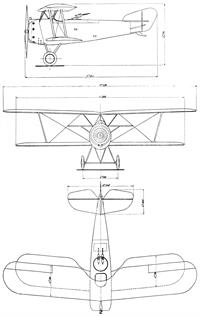

The Hanriot H.43 was a military utility aircraft produced in France in the late 1920s and early 1930s which was primarily used by the Aéronautique Militaire as a trainer. While Hanriot had spent most of the 1920s manufacturing further and further developments of the HD.14 that had flown in 1920, the H.43 was an entirely new design. It was a conventional single-bay biplane with staggered wings of unequal span and a fuselage of fabric-covered metal tube. Accommodation for the pilot and passenger was in tandem, open cockpits and the main units of the fixed, tailskid undercarriage were linked by a cross-axle.
Two prototypes in 1927 were followed by the LH.431 in 1928, a much-modified version that dispensed with the sweepback used on both the upper and lower wings of the H.43, had a new tail fin and added metal covering to the sides of the fuselage. This was ordered into production by the Aéronautique Militaire, which ordered 50 examples. These were slightly different again from the LH.431 prototype, having divided main undercarriage units, wings of slightly greater area, and redesigned interplane struts.
From 1927 to 1933, the Army would purchase nearly 150 examples for a variety of support roles including training, liaison, observation, and as an air ambulance. At the Fall of France in 1940, 75 of these aircraft remained in service.
H.43 variants were also operated by civil flying schools in France, as well as 12 examples purchased for the military of Peru

| Type |
Two-seat trainer |
| Engine |
1 Salmson 9Ab |
| Dimensions |
Length 7,72 m , height 3,29 m , span 11,40 m , wing area 30,24 m2 , |
| Weights |
Empty 930 kg, loaded , max. take off weight 1420 kg |
| Performance |
Max.. speed 180 km/ , cruising speed , range 450 km, endurance , service ceiling 4100 m , climb |
| Type |
Werk.Nr |
Registration |
History |
|
|
|
|


